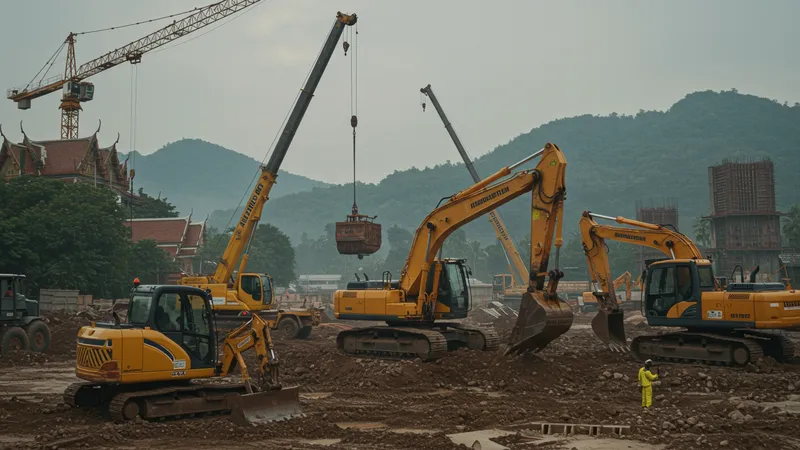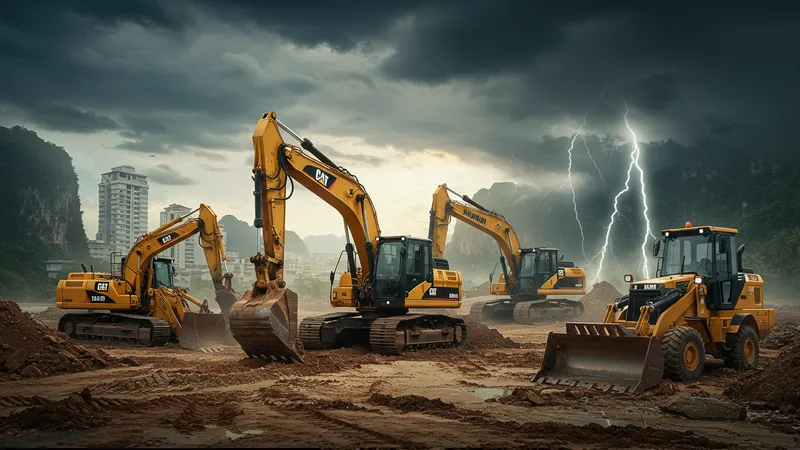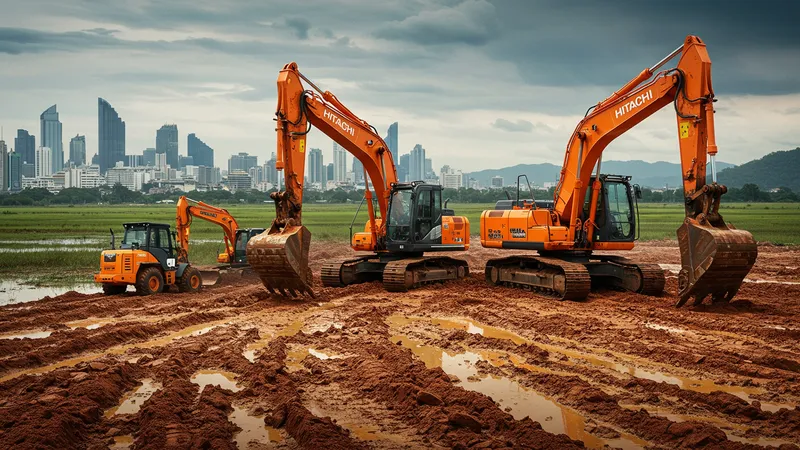

For construction projects in Thailand, selecting machinery is more than just choosing the biggest crane or the fastest excavator. The process involves balancing efficiency, cost, equipment suitability, and reliability—all of which must conform to Thailand’s unique infrastructure needs and climate. Whether gearing up for large-scale commercial work or residential site development, the choice of equipment can significantly affect timelines and project outcomes.
Locating the ideal machinery for construction in Thailand involves understanding local regulations, recognizing climate demands, and seeking equipment that aligns with technical requirements. Equipment performance and after-sales service are crucial, as delays due to maintenance or mismatched machinery can result in project setbacks. Choosing well means analyzing brands, considering dealer support in Thailand, and balancing upfront costs against long-term reliability.

All three of these leading machines are designed for the heavy-duty needs of Thailand's most active sites. The Komatsu PC200 is prized for its fuel efficiency and easy maintenance, making it popular for construction in both dense urban and rural areas. Caterpillar’s 320 GC is known for durability and comfort, especially in Thailand’s hot and humid climate, which can strain older models. Hitachi’s ZX200-5G adds advanced hydraulic technology that improves productivity on sites with variable terrain.
An understanding of local availability is central to the decision-making process. Unlike foreign markets, Thai construction managers must also factor in the proximity of spare parts providers, response times for service, and the prevalence of experienced operators for specific brands. For example, dealers in Thailand often bundle essential support services with machinery purchases, a practical advantage.
Costs extend beyond the sticker price. In Thailand, import duties, after-sales packages, and regional transport fees can form a significant portion of the real investment. It's common for buyers to compare financing and leasing offers that are tailored to the local marketplace, which influences the decision as much as machine specs do.
Finally, climate and seasonal weather matter. Machines routinely exposed to Thailand’s heavy rains and high humidity require specific features, such as water-resistant electronics and reinforced cooling systems, to ensure longevity. These environmental considerations often determine which model stands the repeated test of Bangkok traffic or remote rural site access.
These initial factors are just the start. The deeper details reveal even more valuable insights ahead on how successful Thai builders select the perfect machinery for every job, from skyscrapers to infrastructure upgrades.
Performance consistency is paramount when choosing construction machinery for Thailand’s diverse environments. Heavy machinery needs to cope with both urban density and remote, rugged sites. Equipment that is engineered for tropical climates—like reinforced cooling systems or corrosion-resistant parts—can outperform imported models that aren’t adapted for heat and humidity.

Reliability directly impacts project deadlines in Thailand’s fast-paced construction sector. Downtime caused by machinery faults or servicing delays can trigger costly setbacks, especially during monsoon months when weather windows are tight. Manufacturers like Caterpillar, Komatsu, and Hitachi invest in robust after-sales service networks across Thai provinces to minimize such risks.
Operator comfort is another performance factor often overlooked. Machines with climate-controlled cabs, intuitive controls, and ergonomic seating reduce operator fatigue, increasing productivity across long shifts. Both the Komatsu PC200 and Caterpillar 320 GC have made this a design priority, reflecting feedback from local construction teams who face extended periods working in Thailand’s challenging climate.
Finally, machine adaptability is crucial. The ability to switch attachments—such as buckets, breakers, or grapples—adapts the machinery for site-specific tasks, eliminating the need for additional equipment. In Thailand, brands like Hitachi have developed versatile hydraulic systems allowing for quick changes of function, optimizing both cost and efficiency on every job.
In Thailand, price transparency and long-term value are decisive factors for construction machinery purchases. Equipment investment goes well beyond the initial sales figure. Thai buyers routinely calculate the total cost of ownership, including fuel consumption, maintenance expenses, spare parts pricing, and expected depreciation over several years.

Financing structures are influential in this market. Many suppliers in Thailand offer tailored payment plans and leasing options to suit project-based budgets. This enables small and medium-sized contractors to access new, higher-spec equipment without large upfront cash outlay, a model common among Komatsu and Caterpillar dealers in Bangkok and regional centers.
Import taxes and duties on heavy equipment also impact budgeting. Machinery manufactured or assembled in ASEAN countries may carry lower duties, which can shift preferences among local buyers. Comparing multiple suppliers for their inclusive packages—bundling warranty service, free parts for a set time, or operator training—can result in significant long-term savings.
Considering resale value is essential too. Brands with established dealer networks and strong reputations, such as Hitachi, tend to maintain higher residual values. Thai contractors often check historical pricing and auction trends as part of their asset planning strategy, ensuring their equipment can be liquidated without steep value loss if project needs change.
The breadth of a dealer’s support network is a crucial selection criterion for Thai contractors. It ensures prompt supply of spare parts, professional repairs, and technical advice in any region. Urban hubs like Bangkok, Chiang Mai, and Rayong offer excellent coverage for major brands, while regional outreach is steadily expanding to serve construction growth across the country.

Warranty packages and on-site maintenance services differentiate one dealer from another. In Thailand, it's common for equipment suppliers to provide emergency response units and preventive maintenance as part of the purchase. This approach keeps machines like the Caterpillar 320 GC and Komatsu PC200 operational during crucial build phases, where every hour can impact earnings.
Training programs for operators and site mechanics enhance machinery efficiency and safety. Leading Thai dealers invest in certified courses tailored to the specific requirements of their equipment. This ensures each machine is deployed with optimal care and maximized productivity, even in challenging or unfamiliar terrain.
Dealers often offer telematics and digital monitoring as a standard feature with new machines. Kobelco, for instance, supplies systems that allow Thai project managers to track machine health and performance in real-time, pre-empting problems before they halt operations. This level of support represents a significant competitive edge in the local market.
Thailand’s climate is characterized by intense heat, seasonal monsoons, and substantial humidity, all of which place extra strain on construction machinery. Equipment must be adapted to handle water ingress, mud, and fluctuating temperatures. Machines with sealed electronics and robust cooling are favored in regions prone to flooding and downpours.

The country’s varied terrain—from Bangkok’s congested cityscape to the undulating north and the soft, marshy ground of the central plains—requires a mix of crawler and wheeled excavators. Brands like Hitachi and Komatsu have introduced models with adjustable undercarriages or enhanced stability systems to meet these geographical demands.
Seasonal cycles can govern construction timelines. Smart contractors in Thailand time machinery deployment before the onset of heavy rains and select models with track record for all-weather reliability. Choosing equipment that stays efficient through both wet and dry months helps keep builds on schedule and budgets under control.
Environmental regulations in Thailand increasingly encourage greener machinery with lower emissions and noise output. Electric and hybrid options, while still emerging in this region, are beginning to influence procurement policies, especially for urban infrastructure projects where pollution and community impact are front of mind.